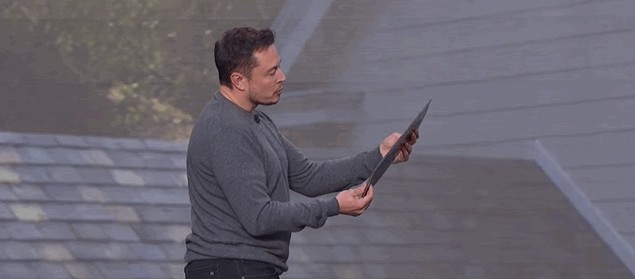
Tesla just slashed prices on its residential solar systems by 10 to 20 percent — or $3,000 to $5,000 for the typical home solar roof.
The average price drop will amount to between 10 and 15 percent “depending on the market,” with drops of “more than 20 percent” for large system customers. A Tesla spokesperson attributed the price reduction to “vertical integration” and to shutting down “more expensive sales channels.”
Sanjay Shah, Tesla’s senior vice president of energy operations, told Reuters the price cuts should make Tesla “highly competitive” and potentially the country’s lowest-cost solar installer. Sales and marketing costs have been cut in half, said Shah.
The “soft” cost for an installer to acquire a residential customer in the U.S. has actually risen — increasing from $0.41 per watt in 2013 to $0.52 per watt in 2016 ($3,668 per customer), even while the cost of every other component in the cost stack has plunged. Customer-acquisition costs are significantly higher for larger solar installers.
So Tesla changed its tactics. SolarCity’s door-to-door sales channel (with an average customer acquisition cost of $4,500, according to Wood Mackenzie Power & Renewables) was dropped, as was its in-store partnership with Home Depot (with its customer-acquisition cost of $7,000). Tesla laid off 9 percent of its workforce in June of this year.
As of now, Tesla is selling solar (and energy storage) exclusively at its more than 100 retail locations and online.
Although Tesla’s solar installations have plunged, Tesla did deploy 93 megawatts of solar systems in the third quarter (mostly loans and cash sales) — an increase over the previous quarter’s 84 megawatts. As a point of reference, SolarCity installed 272 megawatts in the last quarter of 2015. Sunrun has replaced SolarCity as the leading installer and third-party-ownership financier.
Still, Tesla’s solar deployments are on the rise. Perhaps reduced solar prices combined with an online or in-store sales engine may be the solution to historically intransigent customer-acquisition costs.
Tesla’s energy storage business grew to 239 megawatt-hours last quarter — more than double the same quarter last year. The company claims that it is on track to triple energy storage deployments year-over-year.
Along with that growth, Tesla is helping usher in a new type of electric utility model with really big batteries replacing fossil fuel generators. The California Public Utilities Commission just approved Pacific Gas & Electric’s proposal to build the two largest battery systems in the world. As GTM’s Julian Spector reports, the vote is “a landmark development in California’s quest to decarbonize its electrical system by shifting from natural gas to non-emitting sources for flexible power.”
Four projects, totaling 567.5 megawatts/2,270 megawatt-hours, are slated for the transmission-constrained Moss Landing area south of San Francisco, including a 182.5-megawatt/730-megawatt-hour Tesla system that PG&E would own.
BP Wind Energy deployed a Tesla 212-kilowatt/840-kilowatt-hour battery system at its Titan 1 Wind Energy site in South Dakota, a first for BP in the U.S. The battery will help manage internal electricity needs of turbines when the wind isn’t active.
Last quarter, Tesla’s CEO suggested that “delivery hell” stemmed from lack of carriers to transport its vehicles.
Yesterday, Musk tweeted a remedy: “We bought some trucking companies & secured contracts with major haulers to avoid trucking shortage mistake of last quarter.”
Musk wants to reduce the time it takes to get a car from the factory to the customer and says that Model 3 orders placed by November 30 can be delivered in the U.S. by December 31.
Musk added that skipping rail “saves over a month for East Coast deliveries,” explaining, “All things considered, it’s better to use trucks. Single load/unload & direct to owner location.”
Josh Wolfe, fund director of Lux Capital, tweeted a response: “All things considered, makes no sense. First principles? Using lots of trucks instead of trains — is NOT environmentally friendly. Accelerates CO2 emissions and dirty diesel and decelerates world’s transition to sustainable energy.”
It turns out that Elon is the normal one: Fox News shut down an off-the-rails interview with Tesla board member and CEO sibling Kimbal Musk.
One Canadian Tesla owner reports good winter performance — but no donuts for you. Perhaps in track mode.
Where’s Tesla? Alphabet’s self-driving automobile unit Waymo is about to launch a limited ride-hailing service in Phoenix, Arizona as soon as next month, according to a Bloombergsource, intending to challenge Uber and Lyft head-on.
GM targets its ride-hailing service, piloted by a Chevrolet Bolt devoid of steering wheel or foot pedals, for late 2019. Ford’s self-driving car service, powered by its $1 billion investment in Argo AI, will deploy “at scale” in 2021, according to a recent announcement.
The Boring Company has a position open for a “watchtower guard,” which, of course, involves this Twitter nerdfest of Monty Python references from Musk and followers.
Not news: Tesla owner receives a well-built Model 3 provided with good customer service.
Mexico’s Tequila Regulatory Council is infeliz with Elon Musk’s trademarking of a beverage called “Teslaquila,” according to Automotive News.
Avots: green tech media